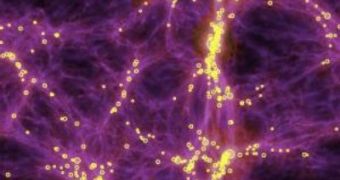A powerful supercomputer was recently used to help astronomers in their quest to find answers to the questions of cosmic evolution. The mathematical equations of black holes were introduced into this supercomputer, which produced the most comprehensive simulation of universal evolution in terms of black holes formations inside galaxies.
The simulation is called BHCosmo and proves that these black holes are truly vital for the structure of the universe which could help guide the telescopes of the near future by presenting specific locations where they should look in order to find the earliest cosmological events.
Scientists from Carnegie Mellon University, the Harvard-Smithsonian Center for Astrophysics and the Max Planck Institute for Astrophysics in Germany were involved in this project that hopes to untangle the history of our universe.
"Ours is the first simulation to incorporate black hole physics," said theoretical cosmologist Tiziana Di Matteo, associate professor of physics at the Mellon College of Science at Carnegie Mellon. "It is very computationally challenging, involving more calculations than any prior similar modeling of the cosmos, and the result offers us the best picture to date of how the cosmos formed."
The system used is called Cray XT3 and it's the powerful system the National Science Foundation's TeraGrid has to offer. The scientists used it to perform simulations that took into account black holes, an impossible task for all other computers previously used, because of the huge amount of mathematical data associated with the physics of black holes.
"Including black holes in computer simulations is critical. The galaxies we see today look the way they do because of black hole physics," added Springel, junior research group leader at Max Planck. "We must do simulations to understand the role black holes have played in forming structures of both the early universe and today."

 14 DAY TRIAL //
14 DAY TRIAL //